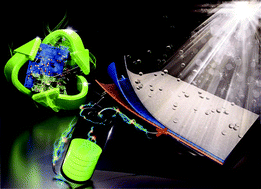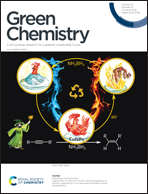Dual functionality of mixed Cu-based two-dimensional (2D) heterostructures derived from electronic waste†
Abstract
Growing concerns over non-renewable fossil fuel resources and anthropogenic emissions of greenhouse gases have attracted global interests towards development of sustainable and renewable energies using functional nanostructures. A sustainable approach that can confer multiple advantages is the engineering of nanostructures from the recycling of electronic waste (e-waste) materials. The present work reports a simplified, high-yield, and controllable strategy to prepare Cu-based heterojunction ultrathin films with a stratified morphology, in which the number, composition, and structure of two-dimensional (2D) Cu-based layers can be tailored. As electrodeposited, the bilayer Cu/Cu2O–Cu(OH)2 exhibited a pseudocapacitance behaviourwith high power density offering a promising potential for energy storage applications. A rapid post heat-treatment at a low temperature led to a partial transformation of Cu and Cu2O–Cu(OH)2 layers into CuO, resulting in the formation of a trilayer heterojunction ultrathin film with high energy harvesting performance as a photocathode for hydrogen production, in which the enhanced electron/hole separation and increased number of active sites across the interfacial regions resulted in photoelectrochemical current density as high as 2.6 mA cm−1 at −0.6 V vs. Ag/AgCl. To evaluate the environmental impacts associated with the valorisation process, a Life Cycle Assessment (LCA) containing four possible scenarios was comprehensively conducted. The LCA results highlighted (a) the critical requirement for sustainable and less-polluting chemical agents and substrates, and (b) the importance of such value-added recycling for the environment and the immense potential of e-waste applicability in developing advanced functional nanomaterials.



 Please wait while we load your content...
Please wait while we load your content...